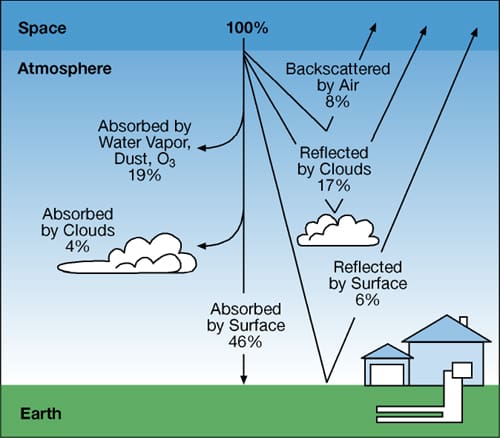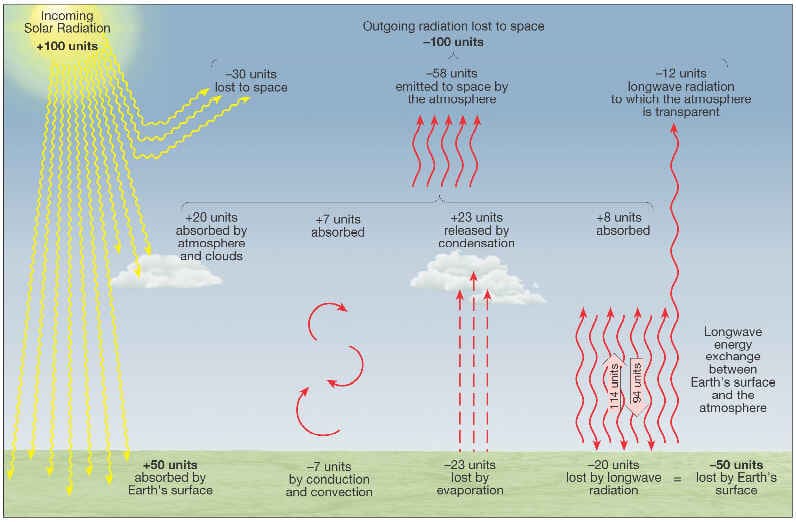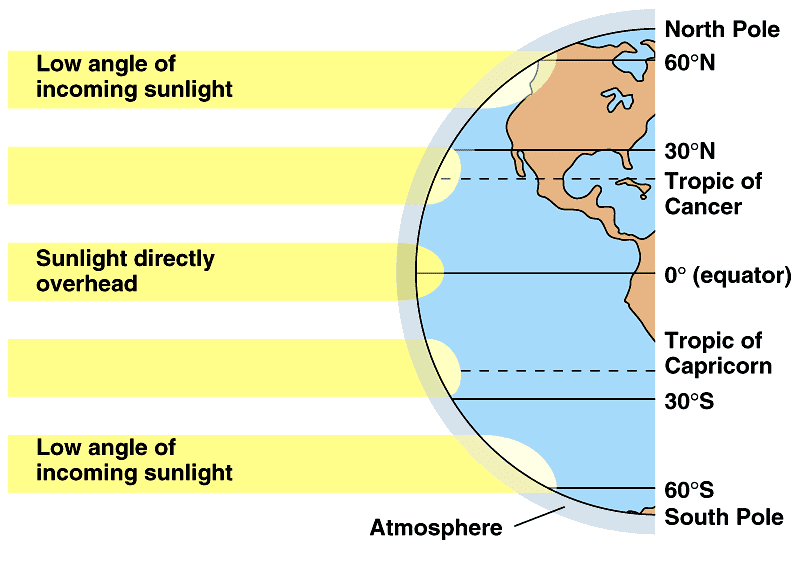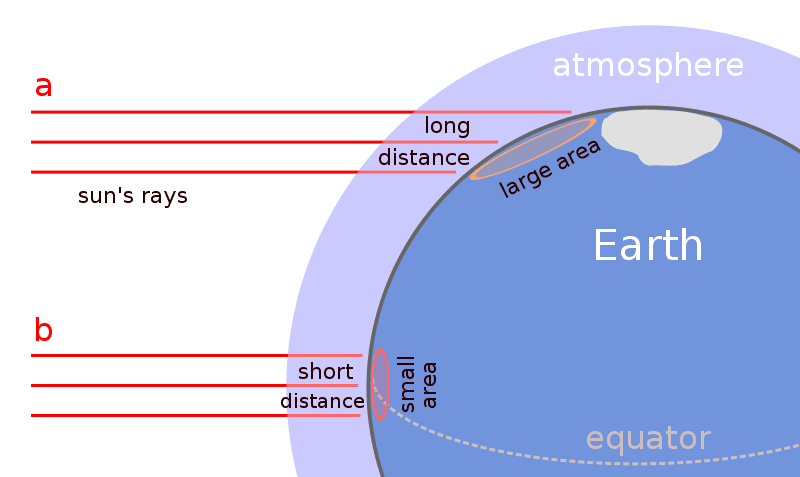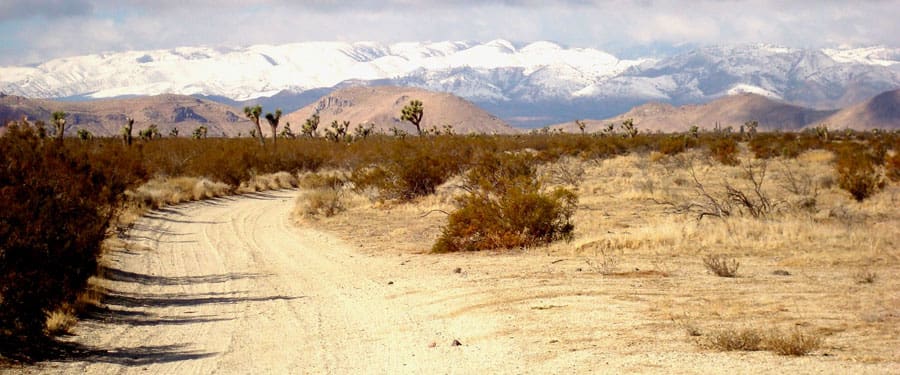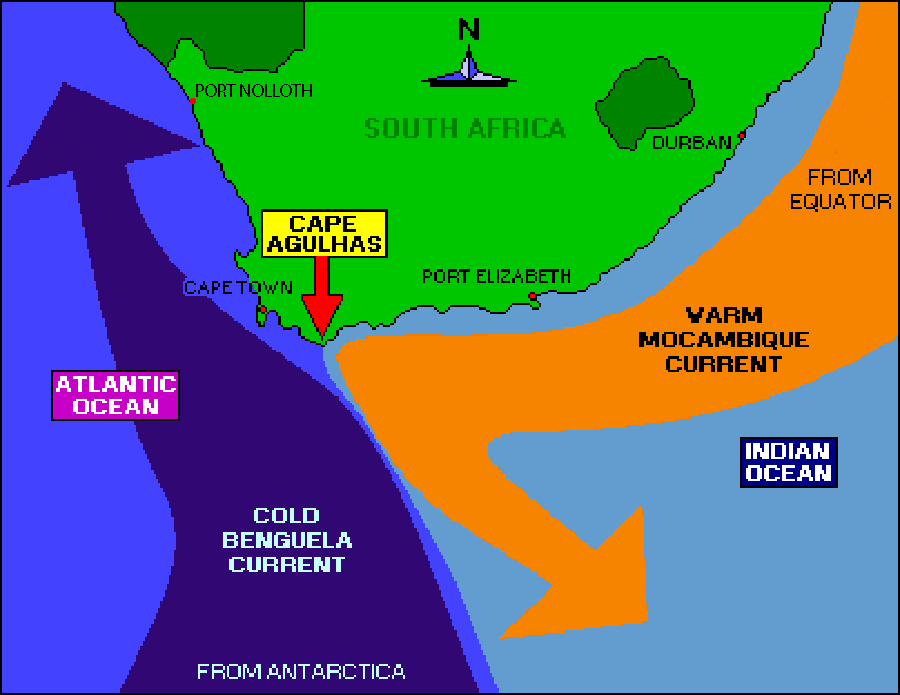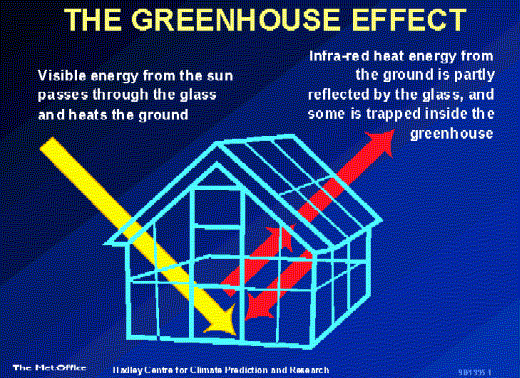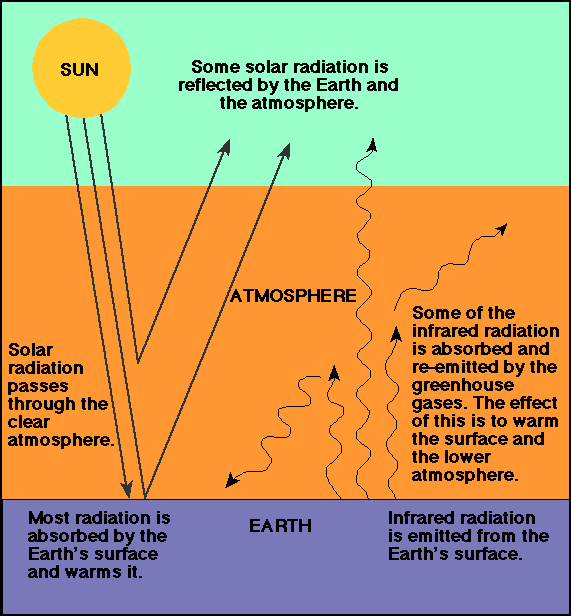1. Processes associated with the heating of the atmosphere: insolation, reflection, scattering, absorption, radiation, conduction and convection.
1.1 INSOLATION: INcoming SOLar radiATION
The sun’s energy received by the earth.
1.2 Reflection:
The opposite of absorption. Insolation is redirected back into the atmosphere, mostly by clouds.
1.3 Scattering:
Small particles and gas particles diffuse (scatter) the insolation. Scattering reduces the amount of insolation and can result in some insolation returning to the atmosphere. Scattering is the reason our sky is blue.
1.4 Absorption:
The process in which insolation is retained by a substance and converted into heat energy. The creation of heat energy causes the substance to emit its own radiation. The earth is an example of this. The earth is heated up and re-radiates this energy into the atmosphere.
1.5 Radiation:
The emission of energy from an object
1.6 Conduction
The transfer of heat energy from one object to another.
1.7 Convection
The transfer of heat energy by the vertical movement of air.
2. Factors that affect the temperature of different places around the world: latitude, altitude, ocean currents and distance from oceans.
2.1 Latitude:
Latitude refers to the distance to the north and south of the Equator and increases as we move away from the Equator.
Relationship: The amount of heat received by the Earth’s surface decreases as latitude increases. Angle of Incidence: Along the Equator, the Sun’s rays strike the Earth’s surface more directly. This causes the solar radiation to be concentrated over a smaller area, causing more intense heat hence the equatorial region experiences a higher temperature At the higher latitudes, the Sun’s rays strike the Earth’s surface at an angle. This causes the solar radiation to be spread over a larger area, hence the higher latitudes experiences a lower temperature.
Distance: In the higher latitudes as the Sun’s rays need to travel a greater distance through the atmosphere before reaching the Earth’s surface. Solar energy that reaches the atmosphere’s upper layers are absorbed by oxygen, ozone and other molecules before it reaches the surface. The further these molecules have to travel the more solar energy is absorbed.
2.2 Altitude
Altitude refers to the height of a point above the level of the sea surface.
Relationship: The higher the altitude, the lower the temperature.
- The atmosphere consists of water vapour and other gases which absorb heat from the Sun. There is a higher concentration of atmospheric molecules due to the force of gravity hence most of the Sun’s heat is absorbed at or near sea level.
- The same atmospheric molecules are warmed by heat radiated from the Earth’s surface hence temperature is higher at the lower altitudes.
2.3 Ocean Currents
Durban and Port Nolloth are both found at 30°S and at sea level, but have very different climates. Durban’s temperatures are consistently warmer than Port Noloth’s. This is due to the warm Mozambique current flowing South past Durban and the cool Benguela current flowing north past Port Nolloth. These currents act to regulate the temperatures of the places found near them. Note: The warm Mozambique current also ensures that the Eastern part of South Africa has more rainfall than the rest of the country.
| West Coast Town - Port Nolloth (30°S) | East Coast City - Durban (30°S) |
|---|---|
Average monthly temperatures for Durban and Port Nolloth
| Jan | Feb | Mar | April | May | June | July | Aug | Sep | Oct | Nov | Dec | YEAR | |
|---|---|---|---|---|---|---|---|---|---|---|---|---|---|
| Durban (°C) | 24.3 | 24.5 | 23.7 | 21.9 | 19.5 | 17.5 | 17.2 | 18.2 | 19.4 | 20.5 | 21.9 | 23.3 | 21.0 |
| Port Nolloth (°C) | 16.3 | 16.5 | 16.0 | 15.2 | 14.5 | 14.2 | 13.1 | 12.9 | 13.3 | 14.1 | 15.2 | 16.1 | 14.8 |
2.4 Distance from the sea
The land heats up quickly, but cools down quickly. The ocean takes much longer to heat up than the land, but takes much longer to cool down than the land.
For places close to the ocean, the ocean can have a cooling effect in summer and a warming effect in winter. The KwaZulu Natal coastline would be far hotter in summer were it not for the cooling effect of the Indian ocean, and far cooler in winter were it not for the warming effect of the Indian ocean. Places inland are generally warmer in summer and cooler in winter.
3. The Greenhouse Effect – impact on people and the environment.
The Greenhouse Effect and Global Warming
4. Global warming: evidence, causes, and consequences, with reference to Africa. 5. The impact of climate and climate change on Africa’s environment and people – deserts, droughts, floods and rising sea levels.
Some links:
http://www.climatehotmap.org/africa.html
http://news.softpedia.com/news/The-Effects-of-Global-Warming-in-Africa-41077.shtml
http://www.brighthub.com/environment/science-environmental/articles/46601.aspx
